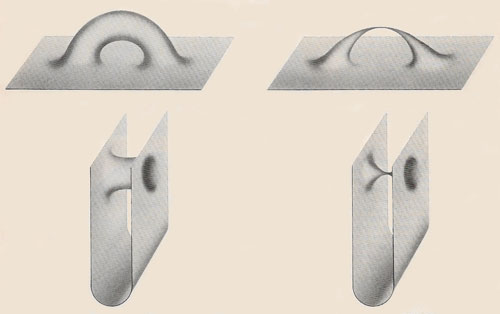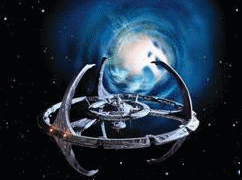wormhole

Schematic representation of wormhole connecting two widely separated points in space and time.

A wormhole in spacetime is a hypothetical structure that could alter the topology of the universe. On a flat plane a wormhole is formed by cutting two openings and stretching the cut edges into tubes that are then joined. On the original plane any closed curve can be shrunk to a point (color). A curve passing through the wormhole, however cannot be shrunk. A wormhole in three-dimensional space or four-dimensional spacetime is not conceptually different.

Distant regions of the universe could in principle be connected by a wormhole, suggesting that faster-than-light communications might be established between them; however, there is a problem. In the drawing of a wormhole at the upper left the distance between the holes in the 'outside world' is comparable to the distance through the 'throat'. In the wormhole at the lower left the outside distance is much greater. In the lower drawings the space represented by the plane appears to be bent, but that is only because it is viewed from the perspective of a higher-dimensional space; to an observer living in the plane it would appear approximately flat. Whether or not the throat is a short cut, it is not possible to pass through it. The reason is that a wormhole invariably connects two black holes. The throat pinches off, as is shown at the right, and anything that enters it is crushed to infinite density before reaching the other side.
A wormhole is a hypothetical 'tunnel' connecting two different points in spacetime in such a way that a trip through the wormhole could take much less time than a journey between the same starting and ending points in normal space. The ends of a wormhole could, in theory, be intra-universe (i.e. both exist in the same universe) or inter-universe (exist in different universes, and thus serve as a connecting passage between the two).
Wormholes arise as solutions to the equations of Einstein's general theory of relativity. In fact, they crop up so readily in this context that some theorists are encouraged to think that real counterparts may eventually be found or fabricated and, perhaps, used for high-speed space travel and/or time travel. However, a known property of wormholes is that they are highly unstable and would probably collapse instantly if even the tiniest amount of matter, such as a single photon, attempted to pass through them. A possible way around this problem is the use of exotic matter to prevent the wormhole from pinching off.
A brief history of wormholes
The theory of wormholes goes back to 1916, shortly after Einstein published his general theory, when Ludwig Flamm, an obscure Austrian physicist, looked at the simplest possible solution of Einstein's field equations, known as the Schwarzschild solution (or Schwarzschild metric). This describes the gravitational field around a spherically-symmetric non-rotating mass. If the mass is sufficiently compact, the solution describes a particular form of the phenomenon now called a black hole – the Schwarzschild black hole. Flamm realized that Einstein's equations allowed a second solution, now known as a white hole, and that the two solutions, describing two different regions of (flat) spacetime were connected (mathematically) by a spacetime conduit.1 Because the theory has nothing to say about where these regions of spacetime might be in the real world, the black hole "entrance" and white hole "exit" could be in different parts of the same universe or in entirely different universes.
In 1935, Einstein and Nathan Rosen further explored, it can be appreciated with hindsight, the theory of intra- or inter-universe connections in a paper2 whose actual purpose was to try to explain fundamental particles, such as electrons, in terms of spacetime tunnels threaded by electric lines of force. Their work gave rise to the formal name Einstein-Rosen bridge for what the physicist John Wheeler would later call a "wormhole." (Wheeler also coined the terms "black hole" and "quantum foam".) Wheeler's 1955 paper3 discusses wormholes in terms of topological entities called geons and, incidentally, provides the first (now familiar) diagram of a wormhole as a tunnel connecting two openings in different regions of spacetime.
Traversable wormholes
Interest in so-called traversable wormholes gathered pace following the publication of a 1987 paper by Michael Morris, Kip Thorne, and Uri Yertsever (MTY) at the California Institute of Technology.4, 5 This paper stemmed from an inquiry to Thorne by Carl Sagan who was mulling over a way of conveying the heroine in his novel Contact across interstellar distances at trans-light speed. Thorne gave the problem to his PhD students, Michael Morris and Uri Yertsever, who realized that such a journey might be possible if a wormhole could be held open long enough for a spacecraft (or any other object) to pass through. MTY concluded that to keep a wormhole open would require matter with a negative energy density and a large negative pressure – larger in magnitude than the energy density. Such hypothetical matter is called exotic matter.
Although the existence of exotic matter is speculative, a way is known of producing negative energy density: the Casimir effect. As a source for their wormhole, MTY turned to the quantum vacuum. "Empty space" at the smallest scale, it turns out, is not empty at all but seething with violent fluctuations in the very geometry of spacetime. At this level of nature, ultra-small wormholes are believed to continuously wink into and out of existence. MTY suggested that a sufficiently advanced civilization could expand one of these tiny wormholes to macroscopic size by adding energy. Then the wormhole could be stabilized using the Casimir effect by placing two charged superconducting spheres in the wormhole mouths. Finally, the mouths could be transported to widely-separated regions of space to provide a means of FTL communication and travel. For example, a mouth placed aboard a spaceship might be carried to some location many light-years away. Because this initial trip would be through normal spacetime, it would have to take place at sublight speeds. But during the trip and afterwards instantaneous communication and transport through the wormhole would be possible. The ship could even be supplied with fuel and provisions through the mouth it was carrying. Also, thanks to relativistic time-dilation, the journey need not take long, even as measured by Earth-based observers. For example, if a fast starship carrying a wormhole mouth were to travel to Vega, 25 light-years away, at 99.995% of the speed of light (giving a time-dilation factor of 100), shipboard clocks would measure the journey as taking just three months. But the wormhole stretching from the ship to Earth directly links the space and time between both mouths – the one on the ship and the one left behind on (or near) Earth. Therefore, as measured by Earthbound clocks too, the trip would have taken only three months – three months to establish a more-or-less instantaneous transport and communications link between here and Vega.
 |
| Star Trek's Deep Space 9 is located alongside a natural
wormhole that leads to the other side of the Galaxy
|
Of course, the MTY scheme is not without technical difficulties, one of which is that the incredibly powerful forces needed to hold the wormhole mouths open might tear apart anything or anyone that tried to pass through. In an effort to design a more benign environment for travelers using a wormhole, Matt Visser of Washington University in St. Louis conceived an arrangement in which the spacetime region of a wormhole mouth is flat (and thus force-free) but framed by struts of exotic matter that contain a region of very sharp curvature.6 Visser envisages a cubic design, with flat-space wormhole connections on the square sides and cosmic strings as the edges. Each cube-face may connect to the face of another wormhole-mouth cube, or the six cube faces may connect to six different cube faces in six separated locations.
In 2011, Panagiota Kanti (University of Ioannina) and Burkhard Kleihaus (Universität Oldenburg) showed how it might be possible to construct traversable wormholes without using exotic matter by resorting to a form of string theory.10
Given that our technology is not yet up to the task of building a wormhole subway, the question arises of whether they might already exist. One possibility is that advanced races elsewhere in the Galaxy or beyond have already set up a network of wormholes that we could learn to use. Another is that wormholes might occur naturally. David Hochberg and Thomas Kephart of Vandebilt University have discovered that, in the earliest moments of the Universe, gravity itself may have given rise to regions of negative energy in which natural, self-stabilizing wormholes may have formed. Such wormholes, created in the Big Bang, might be around today, spanning small or vast distances in space.
References
1. Flamm, L. "Comments on Einstein's theory of gravity," Physikalische
Zeitschrift, 17, 48 (1916).
2. Einstein, A., and Rosen, N. "The Particle Problem in the General Theory
of Relativity", Physical Review, 48, 73 (1935)
3. Wheeler, J. A. "Geons," Physical Review, 97, 511–536
(1955).
4. Morris, M. S, Thorne, K. S., and Yurtsever, U. "Wormholes, time machines,
and the weak energy condition," Phys. Rev. Letters, 61,
1446–1449 (1988).
5. Morris, M. S., and Thorne, K. S. "Wormholes in spacetime and their
use for interstellar travel: A tool for teaching general relativity", Am. J. Phys., 56, No. 5, 395–412 (1988).
6. Visser, M. "Wormholes, baby universes, and causality", Phys. Rev.
D, 41, No. 4, 1116–1124 (1990).
7. Hochberg, D. and Visser, M. "Geometric structure of the generic static
traversable wormhole throat", Phys. Rev. D, Phys. Rev D56,
4745 (1997).
8. Maccone, C. "Interstellar travel through magnetic wormholes", Journal
of the British Interplanetary Society, 48, No. 11, 453–458
(1995).
9. Visser, M. (1995) Lorentzian Wormholes – From Einstein to
Hawking, Woodbury, NY: AIP Press (1995).
10. Kantio, P. and Kleihaus, B., "Wormholes in dilatonic Einstein-Gauss-Bonnet
theory."


